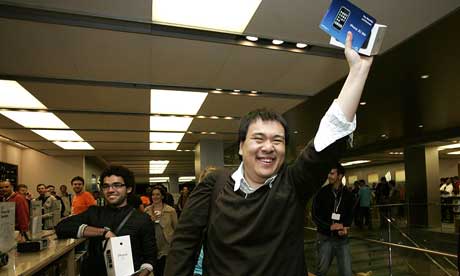Column “Dork Talk” published on Saturday 26th July 2008 in The Guardian
“Well worth the wait” – The Guardian headline
“Ah, but mine can do this! will soon be heard in every cafe and bar.” Stephen Fry is back with an extended review of the iPhone 3G and its downloadable apps
I’m so happy to be back. My thanks to all those who were kind enough to be in touch to say that you missed me. You were well served by my distnguished stand-ins, however, and thanks go to them, too, for keeping Dork Talk alive. But let’s get straight to business: an extra-long column for openers, for this month sees another Apple launch.

A happy customer at the Apple store in London (Photograph: Sang Tan/AP)
Whatever one’s view of Apple as a manufacturer of digital equipment, as an author of operating systems and designer of software, as a multinational corporation, as a lifestyle statement or as a quasi-religious cult, it remains a matter of ineluctable fact that the introduction of the iPhone just over a year ago changed the smartphone market for ever. An incredible three-quarters of all mobile web browsing is now done on the iPhone, despite its market share being far smaller than that of either Windows Mobile, BlackBerry/Java or Nokia/Symbian devices. iPhone users report an unprecedented level of customer satisfaction (between 82% and 90%, compared with the second placed BlackBerry at 50%). This is not a surprise to anyone who has lived with an iPhone for even a short while, and even less of a surprise to anyone who has also had to work with a WinMob phone.
Let’s be clear about the iPhone’s shortcomings, however: this unparalleled success has been achieved by an expensive device with only a 2 megapixel camera, EDGE rather than 3G data speeds, no video, no GPS, no contact search, no file or text manipulation, no Enterprise or MS Exchange capabilities, no third-party applications and a locked-in network operator deal. I said at its launch that this revolutionary implement would thrill early adopters but be prohibitively expensive and under-functional for many others: “Wait for iPhone Three,” I wrote, “that’ll be the one that gets it right.”
A year of living with iPhone One has proved to me that the camera lens and its operation is good enough to produce better photos than phones with twice the resolution, that EDGE speeds allow swift email and full browsing in most areas of the country, that the Google Maps implementation and music, video and photo playback are stunningly impressive, and that other deficiencies are made up for by the sob-worthy beauty, elegance and lovability of another Jonathan Ive-designed Apple masterpiece.
Nonetheless, we want it all, and huge numbers of people have been fretfully awaiting iPhone Two: queuing began in New York a week and half before launch date; O2, the sole UK network provider, had its site go down hours after announcing pre-booking; the BBC’s technology site is so afraid of looking as though it “favours” Apple in some way that it has been failing to file legitimate stories for fear of the anti-Apple community, because, believe it or not, there are people out there who think the launch of yet another Nokia or WinMob Apple-a-like should be given equal prominence.
Well, finally, here it is, the iPhone 3G, hardly different at all in look or feel from iPhone One. The back, available in black or white, is now plastic, which offers better reception for the 10 radios hidden inside – four GSM (your standard quad band), three UMTS/HSDPA (your 3G) plus one each for A-GPS, Wi-Fi and Bluetooth. A standard earphone socket replaces the unpopular recessed jack and the switches are now metal.
This new phone’s greatness is not revealed in its outer lineaments, however, gorgeous as they are, software is crucial. Simultaneous with its release comes Version 2.0 of the operating system. Exchange and enterprise capability (for BlackBerry-style “push email”) has arrived, meaning that the iPhone is now a serious corporate contender: employee pester-power will see to it that it becomes the tool of choice for medium to large businesses that aren’t so pompous and deluded as to think dullness and bad design are a sign of probity and business acumen.
What else is new? The camera is the same. Contacts are finally searchable, a fuller range of email attachments can now be read and saved, a server-side push system for mail, events and contacts called Mobile Me has been introduced (subscription required) and, most importantly of all, Version 2.0 users (including those with original iPhones) will find an “Installer” icon on their home screen. This will be familiar to rebellious criminals like me who “jailbroke” their original iPhones months ago. It means that the power of the iPhone as a beautiful, smooth and function-rich handheld computer can now be realised. Anyone may now write for the iPhone. Existing applications (games, utilities, ebooks, dictionaries and so forth) already written for other platforms can be ported into Apple’s elegant and intuitive developer’s kit with astonishing ease. All applications have to be downloaded through the iTunes store. Believe me, in a very few weeks you will see things being done on an iPhone that will make you gasp and stretch your eyes. The built-in accelerometer alone will inspire people to amazing new heights of ingenuity. The accelerometer is a sensor that knows which way up the iPhone is: you can expect pedometer software, software that plays you music chosen according to how fast you are walking and where you are walking (thanks to the GPS), spirit levels, pinball games with tilt, games in which the iPhone itself is the steering wheel, apps that show you on a map where friends are – we cannot even guess what is coming.
I should digress here to point out that the latest HTC Touch Diamond (HTC is a wonderful manufacturer permanently hamstrung by its devices all being Windows Mobile) has an accelerometer, too, and comes with a ball-manipulation game that provides tactile feedback – you can actually feel the weight and bounce of the ball as you manoeuvre it. For the rest, it is yet another iPhone wannabe: it is too small, its multi-touch interface is too slow on the uptake and the whole experience is rather fiddly. It does have the best browser on a pocket PC I’ve yet seen, however, and for those determined not to go Apple, it is (thanks to the market-changing influence of the iPhone) a superior model of its kind (RRP £499, htc.com for stockists).
Unlike the iPhone 3G, the Diamond also has a front-facing camera (for video calls and video IM). What else is the iPhone 3G missing? No text manipulation (not even basic cut and paste), no Flash plug-ins for the browser, no video recording, no voice memos. Third parties will probably address these software issues, but it would have been better if Apple had solved them itself.
Perhaps the most significant development of all, however, is price. Apple, in harness with its network providers across the globe, has slashed the cost of both the 8GB and 16GB models. O2 in this country will offer the phone for less than £100, or free, according to tariff and other criteria (from Apple, O2 and Carphone Warehouse stores. The iPhone 3G 8G is free on the £45 and £75 tariffs, £99 on the £30 and £35 tariffs; the iPhone 3G 16GB is free on the £75 tariff, £159 on the £30 and £35 tariff, £59 on the £45 tariff. Go to o2.co.uk/iphone/paymonthly for full details). You are tied to their network, but the all-you-can-eat data package works out as excellent value, given the amount of browsing and downloading you are likely to do. 3G is of little interest to me, as it happens – by the time coverage arrives in rural Norfolk, the rest of the world will be 6G.
In conclusion: some will be disappointed by the phone itself, because they will have expected greater and more fundamental physical changes and improvements. In fact, I still maintain that the third iPhone will be the perfect device. But that is to take nothing away from what July 11 heralded: not evolution but revolution. Now that the Applications store is up and running, you will soon find it a very common sight indeed to see people crowded around each other’s iPhones showing off the latest impossible, breathtaking and groundbreaking application. “Ah, but mine can do this!” will be heard in every cafe and bar. Satirical sketches will be written and performed on Channel 4 mocking the trend. Once again, Apple has changed the rules, and nothing will ever be quite the same again.
Acronyms of the week
UMTS: Universal Mobile Telecommunications System; HSDPA: High Speed Package Data Access Both protocols of the near-broadband mobile speeds generally called 3G, or third generation.
GSM: Global System for Mobile communications The standard cellphone technology used for voice calls.
GPRS: General Packet Radio Service As above, but allowing data communications, such as email and web browsing.
EDGE: Enhanced Data rate for GSM Evolution I know, hopeless acronym. As GPRS, but now fast enough to be called 2.75G… nearly as good as 3G, in other words.
A-GPS, GPS: (Assisted) Global Positioning Satellite For satellite navigation. ‘Assisted’ refers to new versions that allow for better urban signals by utilising cell sites and other clever tricks.
IM: Instant Messaging (Skype, iChat, Jabber, AIM etc).
© Stephen Fry 2008



